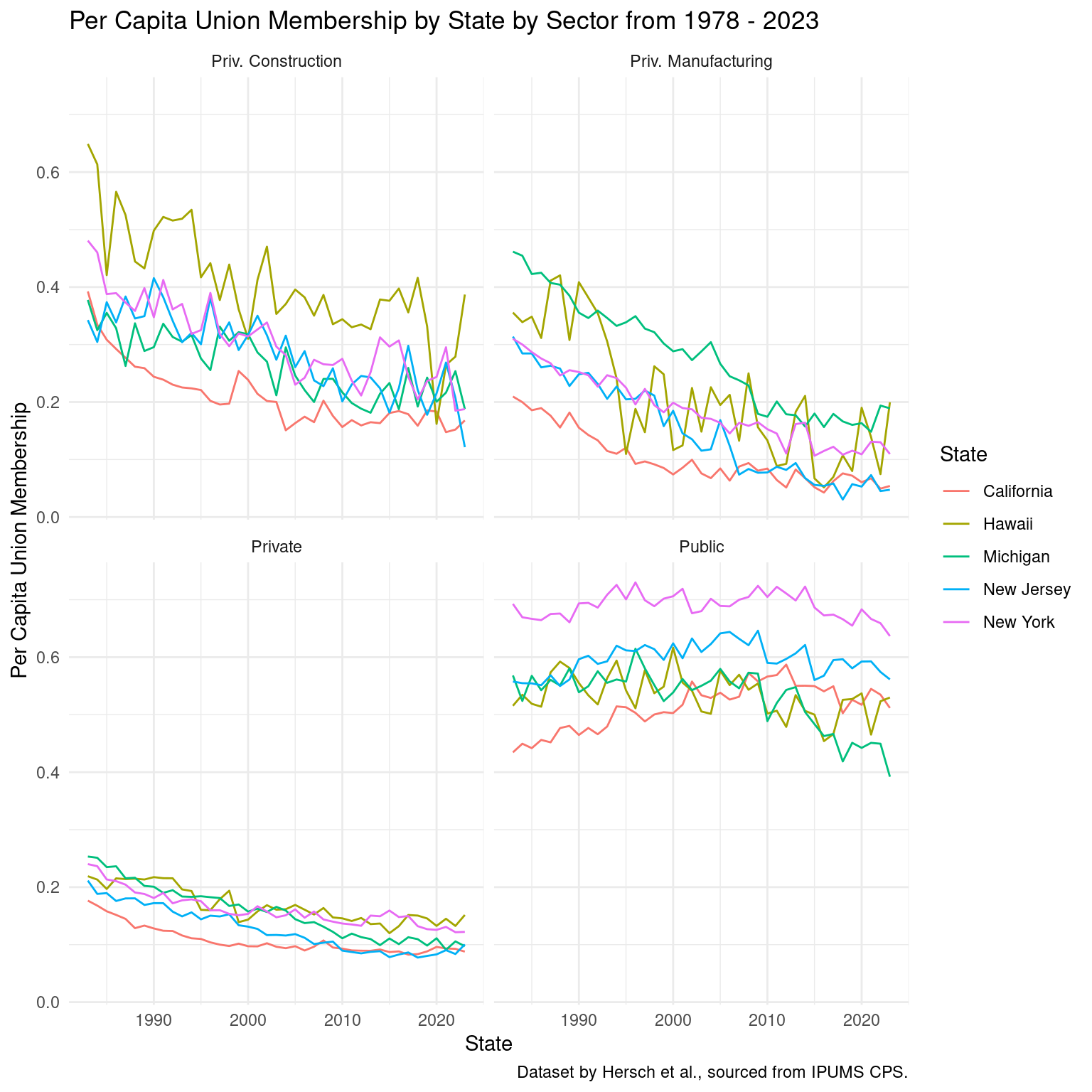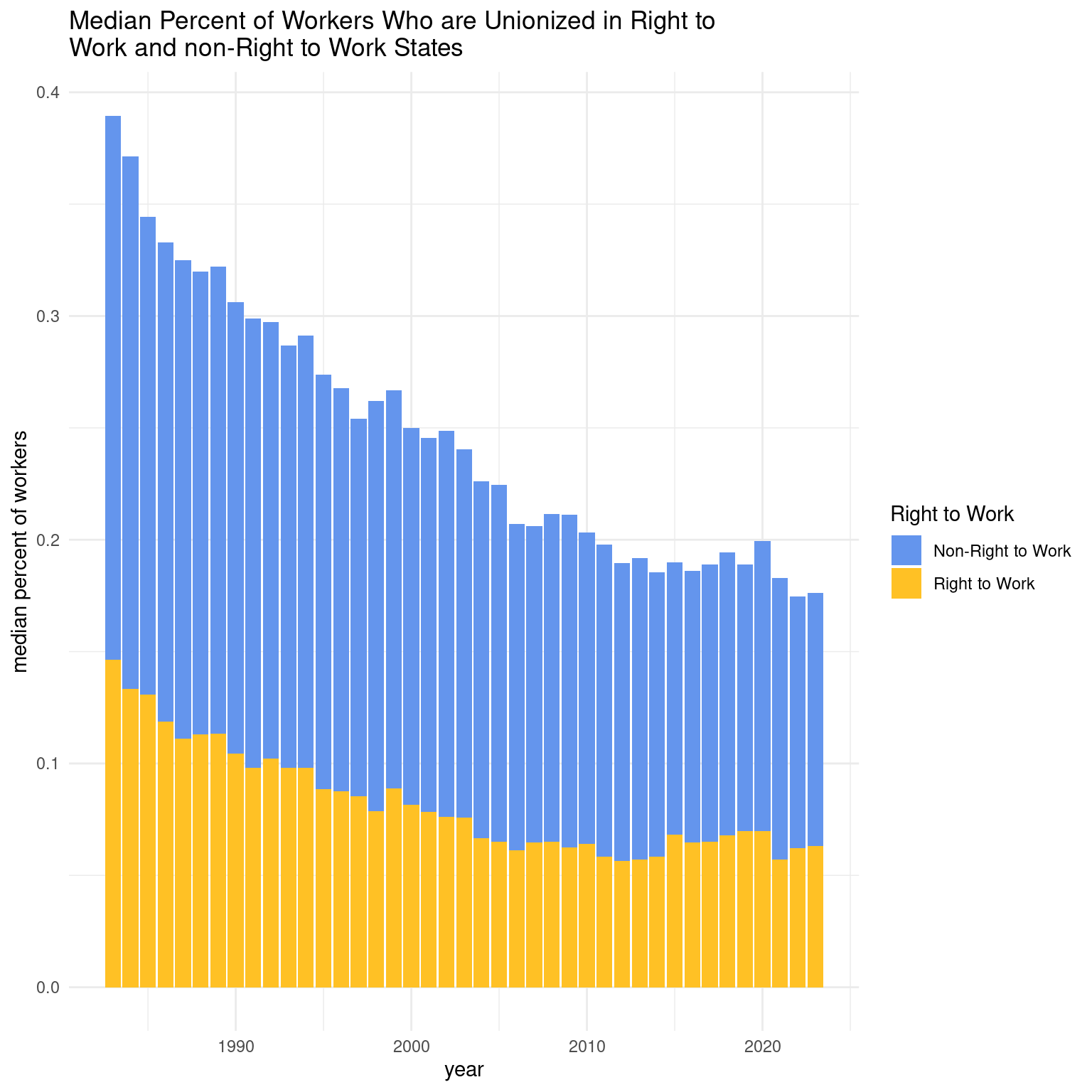Rows: 1,355
Columns: 8
$ year <dbl> 1973, 1974, 1975, 1976, 1977, 1978, 1979, 1980, 1981, 1983…
$ sample_size <dbl> 49095, 48245, 46488, 47648, 57191, 57321, 58080, 68594, 15…
$ employment <dbl> 75519.29, 77101.10, 75703.92, 78776.94, 81334.13, 84966.08…
$ members <dbl> 18088.57, 18176.48, 16778.28, 17402.98, 19335.10, 19548.35…
$ covered <dbl> NA, NA, NA, NA, 21534.60, 21897.54, 23540.08, 22493.37, 21…
$ p_members <dbl> 0.2395225, 0.2357486, 0.2216303, 0.2209147, 0.2377243, 0.2…
$ p_covered <dbl> NA, NA, NA, NA, 0.2647671, 0.2577209, 0.2702135, 0.2571273…
$ facet <chr> "all wage and salary workers", "all wage and salary worker…
Rows: 10,455
Columns: 11
$ state_census_code <dbl> 11, 11, 11, 11, 11, 11, 11, 11, 11, 11, 11, 11, 11,…
$ state <chr> "Maine", "Maine", "Maine", "Maine", "Maine", "Maine…
$ sector <chr> "Priv. Construction", "Priv. Construction", "Priv. …
$ observations <dbl> 85, 93, 95, 89, 114, 117, 119, 109, 78, 62, 59, 55,…
$ employment <dbl> 16917.99, 20170.49, 23411.73, 22873.16, 28033.17, 3…
$ members <dbl> 2207.3308, 2207.7742, 2490.9525, 1917.4617, 3377.06…
$ covered <dbl> 2420.3100, 2207.7742, 2787.8625, 1917.4617, 3377.06…
$ p_members <dbl> 0.13047244, 0.10945567, 0.10639764, 0.08383022, 0.1…
$ p_covered <dbl> 0.14306135, 0.10945567, 0.11907975, 0.08383022, 0.1…
$ state_abbreviation <chr> "ME", "ME", "ME", "ME", "ME", "ME", "ME", "ME", "ME…
$ year <dbl> 1983, 1984, 1985, 1986, 1987, 1988, 1989, 1990, 199…
Rows: 1,273
Columns: 9
$ year <dbl> 1973, 1974, 1975, 1976, 1977, 1978, 1979, …
$ sample_size <dbl> 39774, 37966, 37812, 37888, 46591, 44577, …
$ wage <dbl> 3.963343, 4.258988, 4.622152, 4.914102, 5.…
$ at_cap <dbl> 0.001110298, 0.001568906, 0.002267337, 0.0…
$ union_wage <dbl> 4.613008, 5.021364, 5.428930, 5.835837, 6.…
$ nonunion_wage <dbl> 3.754528, 4.019072, 4.386672, 4.646127, 4.…
$ union_wage_premium_raw <dbl> 0.2286519, 0.2493840, 0.2375963, 0.2560648…
$ union_wage_premium_adjusted <dbl> 0.1717432, 0.1761086, 0.1858174, 0.1967221…
$ facet <chr> "all wage and salary workers", "all wage a…
We will also join two additional data sets: one showing inflation over time so we can adjust the wages and dues, and one listing when Right to Work laws went into effect in each state (if at all).



